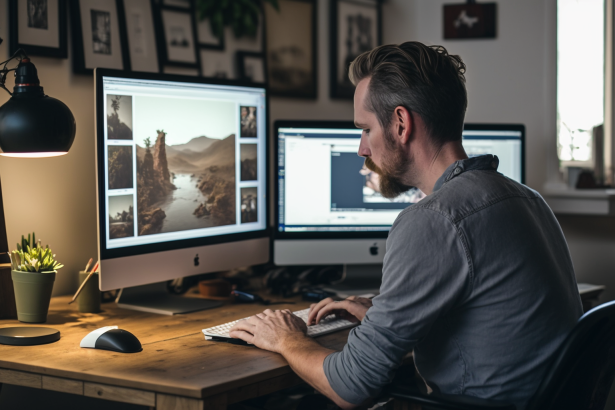Web design includes a range of elements that must be balanced in order to create an effective site. Aesthetics and functionality are two of the most important factors to consider when designing a website, as they will create the overall user experience.
This article examines how Vermont-based web designers balance aesthetics and functionality, providing valuable insights for all web developers.
By understanding their audience, utilizing effective navigation techniques, creating intuitive interfaces, focusing on layout and design principles, and optimizing for mobile devices, web designers can ensure that their sites deliver an optimal experience for users.
Understand Your Audience
- By considering the needs and preferences of the intended users, it is possible to create an interface that provides a smooth user experience.
- Understanding the target audience should be the first priority when creating web designs for Vermont visitors.
- It is important to ensure relevance by keeping up with current trends in terms of design elements, content organization, and other features.
- Additionally, usability should be prioritized through intuitive navigation options and responsive layouts that quickly adapt to different devices and browsers.
- Through careful consideration of the intended audience's needs and interests, designers can create web designs that are both aesthetically pleasing and functional.
Navigation is a key component of successful website design, with 80% of users citing it as the most important factor when assessing usability. When designing websites, effective navigation should be used to minimize distractions and emphasize flow.
Navigation should:
- Provide clear paths for users to navigate the site:
- Ensure that labels are easily identifiable and concise
- Use consistent language throughout the website
- Make sure all links are working properly and redirect visitors to the right pages
Create an intuitive user experience:
- Utilize drop-down menus or expandable tabs when possible to reduce clutter on individual pages
- Consider user flow from one page to another instead of creating isolated experiences in each page
- Use visual cues such as arrows or color changes so that users know where they can go next
Create Intuitive Interfaces
Creating intuitive interfaces is essential for successful website development, as it allows users to quickly find the information they need and interact with the site.
Interactive elements such as buttons, menus, and search bars should be implemented in a way that is easily recognizable and aligned with user expectations.
To achieve this, web designers must use a combination of visual hierarchy, color schemes, typography and other design elements to create an interface that is both visually pleasing and functional.
By carefully considering usability when creating an interface that adheres to these two principles, websites can ensure maximum engagement from their users.
Additionally, feedback from users should be sought out during the design process in order to further refine the interface's intuitiveness.
The lessons learned by Vermont provide valuable insights into how web designers can successfully balance aesthetics and functionality when creating intuitive interfaces for their websites.
Focus on Layout and Design
Responsive design is a web development technique that allows websites to adapt to the size of the user's device. This type of design ensures that content can be accessed and viewed on any device, providing an optimal experience for all users regardless of their preferred platform.
User-friendly color schemes are essential in website design as they provide visual cues which help guide users through the site and create a more pleasant aesthetic.
Responsive Design

By adjusting the size and layout of a website to accommodate different screen sizes, it is possible to provide an optimal viewing experience for users. To achieve this goal, responsive design offers a range of approaches that must be implemented in order to ensure an aesthetically pleasing yet functional design.
This includes:
- Code testing across multiple browsers and devices to ensure compatibility
- Testing the speed of loading times on all platforms
- Ensuring font selection is appropriate for all screens
- Optimizing images so that they are not too large or too small on any given device
- Making sure content remains readable when viewed from different angles or devices.
Responsive design can be used as a powerful tool when balancing aesthetic appeal with function in web design. By taking into account user preferences, usability concerns, and accessibility needs during the development process, designers can create effective designs that will look good on any device while ensuring users have an enjoyable experience no matter what platform they use.
User-Friendly Color Schemes
User-friendly color schemes involve careful selection of colors and hues to create an inviting atmosphere, prompting the question: what elements should be taken into consideration when crafting such a scheme? To develop a strategic palette, it is important to consider both aesthetics and functionality. Aesthetically pleasing palettes should be balanced with accessibility considerations, such as user vision impairments or colorblindness.
One way to achieve this balance is by utilizing tools that provide accessiblity-related feedback on color combinations, such as Contrast Checker or Color Oracle. Furthermore, creating a vibrant yet easy-to-read design can be achieved by using good contrast between text and background colors while also maintaining consistency throughout the website design. Finally, using analogous colors together (colors next to each other on the color wheel) can help create a harmonious feel in web designs.
| Element | Consideration | ||
|---|---|---|---|
| Strategic Palette | Aesthetics & Functionality | ||
| Accessibility Considerations | User Vision Impairments & Colorblindness | ||
| Tools for Feedback | Contrast Checker & Color Oracle | ||
| Text/Background Colors Contrasts | High Contrast & Consistency Throughout Design | ||
| Analogous Colors Combination | Harmonious Feel in Web Designs | To Bring Out a Balanced and Pleasing Look. |
Optimize for Mobile Devices

Optimizing for mobile devices is essential to providing a satisfactory user experience across all platforms. Web designers and developers must consider device compatibility when creating content for websites in order to ensure that the website functions effectively on smaller screens and devices:
- Layout: Designers should focus on developing a responsive layout that adjusts gracefully to the size of any device, from desktop computers to tablets and smartphones. This includes ensuring that all elements are easily visible, readable, and accessible.
- Content: Content should be optimized for mobile devices by removing unnecessary information and reframing text into succinct chunks so that users can quickly find or access important information. Additionally, images should be compressed to reduce load times.
- Testing: It is important to test webpages on various platforms with different browsers to ensure optimal performance across all devices. Tools such as Google's Mobile-Friendly Test are helpful in this regard as they provide feedback on how well a page performs on mobile devices.
By taking these steps, web designers can create effective websites that both look great and are easy-to-use regardless of the device used by the visitor.
Conclusion
Ultimately, Vermont has provided a valuable lesson in balancing aesthetics and functionality in web design.
The combination of intuitive navigation, effective layout and design, and mobile optimization has enabled businesses to create aesthetically pleasing websites that are also highly functional.
This is an invaluable asset for any website, as it allows visitors to easily engage with the content while still enjoying an aesthetically pleasing experience.
In this way, the importance of striking a balance between form and function can be seen as an anachronism; one must find harmony between both aspects in order to create a successful website.




